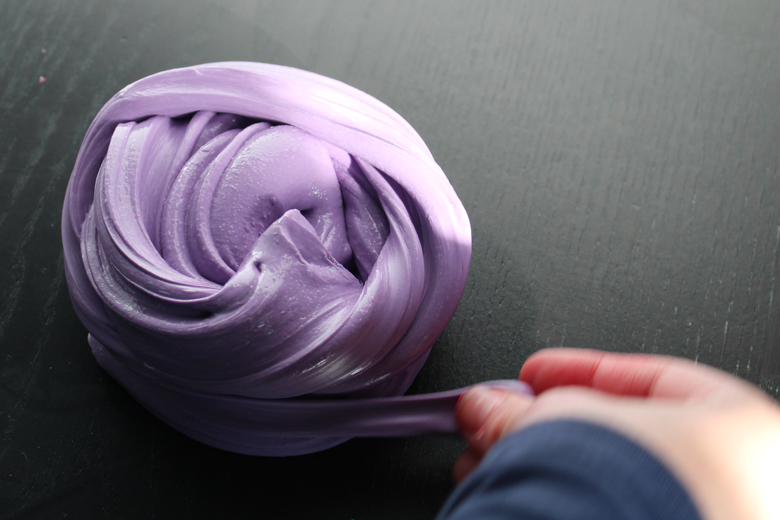Slime for days. Slime for YEARS!
All of the little kid's slimes have original recipes. They all have original names. They all have peculiar qualities that she can tell you all about. None of the rest of us really give her handmade slime hobby the respect that it deserves, so the other morning I took my camera, found her in the playroom (making slime, of course)--
--and said, "Okay, Kid. Show me all your slime."
This is not EVEN all her slime, because my camera battery died. It is, instead, a fairly representative selection:
This is Pink Speck Slime:
It contains glue, red liquid watercolor, liquid starch, glitter, and the tiniest little bit of shaving cream:
This is White Fluffy Slime:
It's made from glue, shaving cream, and liquid starch:
This is Purple Putty Slime:
It's made from one teaspoon thermic powder (which did nothing), glue, liquid starch, and red liquid watercolor:
This is Blue Speck Slime:
It's made from glue, glitter, and liquid starch:
This is Purple Fluffy Slime:
It's made from purple powdered tempera, glue, liquid starch, and shaving cream:
This is Black Glitter Slime:
It's made from a giant heap of glitter, the smallest amount possible of glue, and liquid starch. It's the glitter that makes it black:
This is Yellow Butter Slime:
It's made from stale yellow Model Magic, glue, and liquid starch:
This is White Cloud Slime:
It's made from glue, shaving cream, and liquid starch:
This is Clear Jelly Slime:
It's made from water, clear glue, and liquid starch:
This is Mash-up Slime:
It's made from all of the excess slimes that wouldn't fit into their containers:
This is Pink Floam Slime:
It's made from clear glue, pink floam beads, and liquid starch:
This is the little kid's personal favorite, White Snowy Slime:
It's made from clear glue, a bunch of glitter, liquid starch, and shaving cream:
This is another White Fluffy Slime or White Cloud Slime, although when I told the kid that she had showed me both a White Fluffy Slime and a White Cloud Slime already, she rolled her eyes at me, and when I pointed out that she'd just rolled her eyes at me, she informed me that she was just looking up at the door instead:
It's made from glue, a lot of shaving cream, and liquid starch (and a sarcastic tone and a couple more eye rolls, it seems):
This is Blue Floam Slime:
It's made from glue, blue foam beads, and liquid starch:
This is White Normal Slime:
It's made from glue and liquid starch:
This is Green Sand Slime:
It's made from glue, a little bit of green kinetic sand, and liquid starch:
This is Clear Unicorn Pee Slime:
It's made from clear glue, liquid starch, and some glitter:
Since slime making is the little kid's area of interest, I buy her whatever she asks for as far as slime ingredients go, and sometimes, if I happen upon a recipe with an unusual ingredient, I'll surprise her with something she hasn't asked for--that's how she ended up with the foam beads, which are a hit, the thermochromic powder, which she hasn't been able to make work so far, and some metallic pigments, which she hasn't experimented with yet.
I also bought her saline solution, which she used to make a whole series of slimes that led her to decide that she far prefers to work with liquid starch.
Here are the little kid's favorite slime-making supplies so far:
- 2-ounce plastic storage containers. These work well for giving slime away, especially on Valentine's Day.
- 8-ounce plastic storage containers. These are the standard size that she uses.
- glitter. The kid has recently also asked for large-flake glitter, so we'll make a trip to the craft store this weekend to hunt some down.
- clear glue. I buy this by the gallon.
- foam balls. The dye comes off of these balls when it's mixed into slime, so the kid says that you might as well just buy the white foam balls and dye the slime your color of choice.
- glitter glue. The kid is just as happy dyeing and glittering her slime from scratch, but she likes these, too, so I buy them if I see them on sale.
- white glue. I also buy this by the gallon.
- Stay-Flo liquid starch. This is the kid's ingredient of choice for all of her slimes.
- miscellany. The kid has experimented with all kinds of mix-ins for her slime, everything from sand to beads to dry rice and any other ephemera that comes her way. She also likes to find unusual ingredients to make slime from. She made some awesome slime from stale Model Magic, but the slime that she tried to make from leftover play dough turned into a slimy nightmare that still makes me shudder a bit to think of it.
I don't always appreciate the kid's passion for slime making; it's sticky, and messy, and that playroom table will likely never recover, sigh. But I figure that I bought the playroom table for the kids to use, and the stickiness and messiness is just the kid feeding her senses. She's being creative, she's exercising her STEM skills with all that creating and remixing recipes and discovering new combinations, and she's engaging in whole-body physics and chemistry by exploring the properties of a whole series of non-Newtonian fluids.
And she's mastering the entire field of slime making, and experiencing the confidence and satisfaction of that mastery. What more could I ask glue and starch to do for a person?
P.S. Want to follow along with my craft projects, books I'm reading, road trips to random little towns, looming mid-life crisis, and other various adventures on the daily? Find me on my Craft Knife Facebook page!



























































